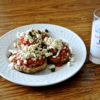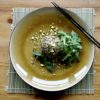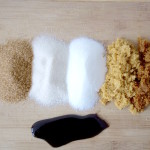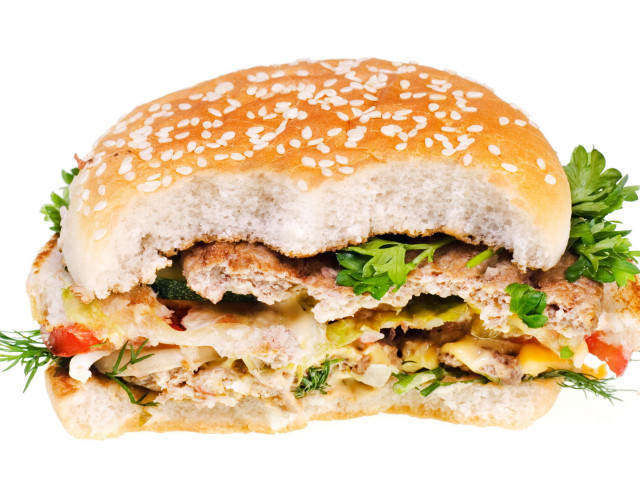
That’s an awful title for a post. Especially at a cooking blog where the daily activities include a large number of indulgences with decadent desserts and rich dishes. However, it seems that it is the motto that society seems to like. I am not going to be cynical and discuss how the super thin models is the image for men and women projected by the media, I think that this blog has already made it clear that this is not what we care about. But it is true that there is an overwhelming pressure of people to look thin not by their peers but mainly by themselves. And that need, as every need that has to do with the self-esteem, has given rise to millions of solutions. From magical pills, to magical work out equipment and the grant jewel of them all; the diets. In this post we will see the history of dieting, some of the different diets and learn the fundamental mechanism that make us lose (or gain) weight.
History of the modern diet
The word diet comes from the Greek word δίαιτα (diaita) that means nourishment and not a nutritional plan to lose weight. Although the concept of food and obesity was very well know even from the ancient Greeks it was not clear what food items cause obesity. An English doctor George Cheyne was one of the first to link a particular type of food (meat in his case) to obesity. He was overweight and would constantly eat large quantities of food and drinks. After successfully loosing weight by avoiding meat, he became one of the most popular advocates of dieting. His ideas were published in 1724, in book entitled “An Essay of Health and Long Life”, were he recommends fresh air exercise and avoiding decadent dishes.
In the next nearly three centuries, we learned a lot more for the composition of foods, the effect of each constituent to human body and their role in obesity and musculoskeletal development. For a large portion of these years the signs of obesity were not considered necessarily negative unless they were associated with health problems. On the contrary a fat belly was a sign of wealth. Only in the middle to late 1800’s where food became more readily available and the medicine had progressed enough the need to lose weight kicked in. One of the first diets was the Banting, pioneered by William Banting a British undertaker. The major principles of his diet are still widely recognizable: four meals a day, consisted mainly on meat, greens and fruits, avoid starchy and sweet items and stay away from butter. That was the model for almost all diets that followed for almost 50 years. But sometime in the 1910’s a big revolution was waiting to happen.
The concept of calorie
An American doctor Lulu Hunt Peters and author of the best-selling book, Diet & Health: With Key to the Calories, conceived for first time the balance of incoming energy and consumed energy. In the book, she was the first to correlate the energy of the food, the energy that humans consume with the weight gain or weight loss. She started a revolution in the dieting that 100 years later is still one of the most popular methods of losing weight and maintaining it. The concept was simple: consume less than you need and the body will be forced to use some of the stored energy to continue his functions. To comprehend this better imagine the following; every day you take your car to work. To go back and forth from your house to work you need one gallon of gas. Every morning you pump one gallon to the car and you are ready to go. If for some reason you add 1.5 gallons you will have half a gallon left over. If you keep doing that for many days you will need an extra tank to hold the excess. This is how your body works too… In a way at least.
Our bodies use energy and whatever is not consumed is stored. Instead of gasoline our bodies are using glucose which is the energy unit the body needs. Through a very complicated route the glucose in the presence of oxygen is turned to Acetyl coenzyme A (acetyl CoA), a molecule that it eventually ends up in the mitochondria in the cells where it is metabolized to generate energy. The molecules that can supply high glucose levels are known as carbohydrates or carbs for short. You intake carbs, and in the amazing engineering marvel that is called human body, they are converted to glucose regardless of how it started. For example white sugar is a fructose and a glucose molecule joined together. The body needs some energy and little time to break it and then hydrolysis fructose create essentially two glucose molecules. Many starchy vegetables and most grains are just a long chain of glucose molecules. Your body will needs a lot more energy and more time to break those down. To go back to the car analogy imagine that your car had a mini oil refinery at the trunk. Instead of gas you were pumping crude oil that had to be refined by your car to gasoline and then use it. This will take energy from the car and slow down the whole process.
This very same concept is the distinction of good vs. bad carbs. Good carbs are generally considered all these long molecules that will take energy in order to be broken down and as a result will have a slow energy release. Examples of those foods are the brown rice, whole grains, vegetables and so on. Eating them, will supply energy that will be slowly released through the day and will also require large energy to metabolize it. Bad carbs are those molecules that have small molecules and release their energy a lot faster. Eating sugar for instance releases in short time large number of energy in the form of acetyl CoA. This is not necessary bad if you will need all this energy that moment. It is bad only if you don’t need the energy and the body cannot use it. In that case, as you are doing with the car, you will need to store it by a process that will convert glucose to fatty acids (through the step of converting glucose to acetyl CoA) that will eventually merge with a help of a glycerol molecule to form a fat molecule that is stored I your hips, belly and other areas. These carbs are all the refined sugars, the processed grains like white flour and generally everything that is sweet tasting. But what happens if there are no carbs? Or not enough carbs?
Well in that case your body has engineered a way to turn fats to acetyl CoA, through a process called beta-oxidation, and then to energy. This process however is slow, and required more energy to convert a fat molecule to a acetyl CoA than a carb molecule to glucose and then to acetyl CoA. So, even if it is possible, your body will never resort to this measure unless there is a complete lack of sugars. This is a very important concept for all type of diets. If you deplete your body from energy you will force it to use the stored fat to cover its needs. All these processes are summarized in the following schematic that is overly simplified but conveys the point. All food constituents can be converted to fat, and fat can only be converted to energy.

And after this mini biochemistry lecture we turn back to the original idea pioneered by Dr. Hunt Peters; the reduction of the energy intake. We know now that regardless of the form of the various constituents every gram of protein, carb and fiber produces 4 kcal of energy and every fat gram about 9 Kcal of energy. Kcal by the way is the abbreviation of what we call calories. One calorie is the energy required to raise the temperature of 1 g of water by one degree C at 1 atm pressure. The symbol for it is cal and kcal means 1,000 cal. Don’t worry 4 kcal does not mean 4,000 calories. In dieting as calorie we define the 1 kcal. So the if we do some fundamental math now we can see how the restriction in calories can result in loosing weight. Assume that someone needs about 2000 kcal a day to get through. That person needs to lose 2 kg of body fat. If he/she reduces his/hers calorie intake by 400 per day then in 5 days he will have used 2,000 kcal less that must be supplied by his stored body fat. We said that each g of fat has about 9 kcal (round it to 10 to make the math easier) which means about 200 g of pure fat. So in order to lose the 2 kg he/she needs to carry one of for about 50 days to achieve that. If he/she reduced her calorie intake by half then she would lose the 2 kg in 20 days.
Let’s just go to the car example for a last time. Imagine as we said that you are using 1.5 gallons per day as opposed to the 1 gallon that you need. The alternative instead of storing it is using it. Take a few trips around the neighborhood to burn it of. Same applies to your body. Reducing your calorie intake from 2,000 to 1,000 practically means reducing your food by half. That’s not very convenient. You will be hungry. Instead you reduce it by 500 calories and you are engage yourself to an extra activity that will require another 1,000 kcal. So your energy difference is 1,500 kcal that will result in the 2 kg weight lose in 13 days. And that, right there is the value of working out, a concept that we will revisit.
But why lose weight? When do you need to lose weight and how much? Well these questions bring us to the next huge step in dieting.
The ideal weight
This is the million dollar question. What is our ideal weight? How much should we weight, and how much weight should we gain or lose based on it. There have been many attempts to quantify that. As a kid I remembered we were saying that it is roughly your height in cm minus 100. So, me an adult with a height of 184 cm should weight 84 kg. That is not bad I guess but it is nonetheless a very crude estimation. Plus it is not supported by any scientific data. This is a questions in many people minds, and naturally a lot of research has been done in the filed.
Currently there are hundreds of formulas and theories developed to answer the age-old question with a more precise manner. All of them have been put to the test, but the answers and accuracy are still debatable. Here I have a list of the most widely used formulas that are copied from the site calculator.net that presents a comparative chart of the various theories.
J. D. Robinson Formula (1983)
- 52 kg + 1.9 kg per inch over 5 feet (man)
- 49 kg + 1.7 kg per inch over 5 feet (woman)
D. R. Miller Formula (1983)
- 56.2 kg + 1.41 kg per inch over 5 feet (man)
- 53.1 kg + 1.36 kg per inch over 5 feet (woman)
G. J. Hamwi Formula (1964)
- 48.0 kg + 2.7 kg per inch over 5 feet (man)
- 45.5 kg + 2.2 kg per inch over 5 feet (woman)
B. J. Devine Formula (1974)
- 50.0 + 2.3 kg per inch over 5 feet (man)
- 45.5 + 2.3 kg per inch over 5 feet (woman)
As the author states all the formulas above are for adults, age 18 or older. For children and teens, please refer to the following weight charts published by the Centers for Disease Control and Prevention (CDC). The various trend lines describing the ideal weight as a function of the height are summarized in the following diagram. You can see that more or less all of them are within the same narrow range for men of average height.
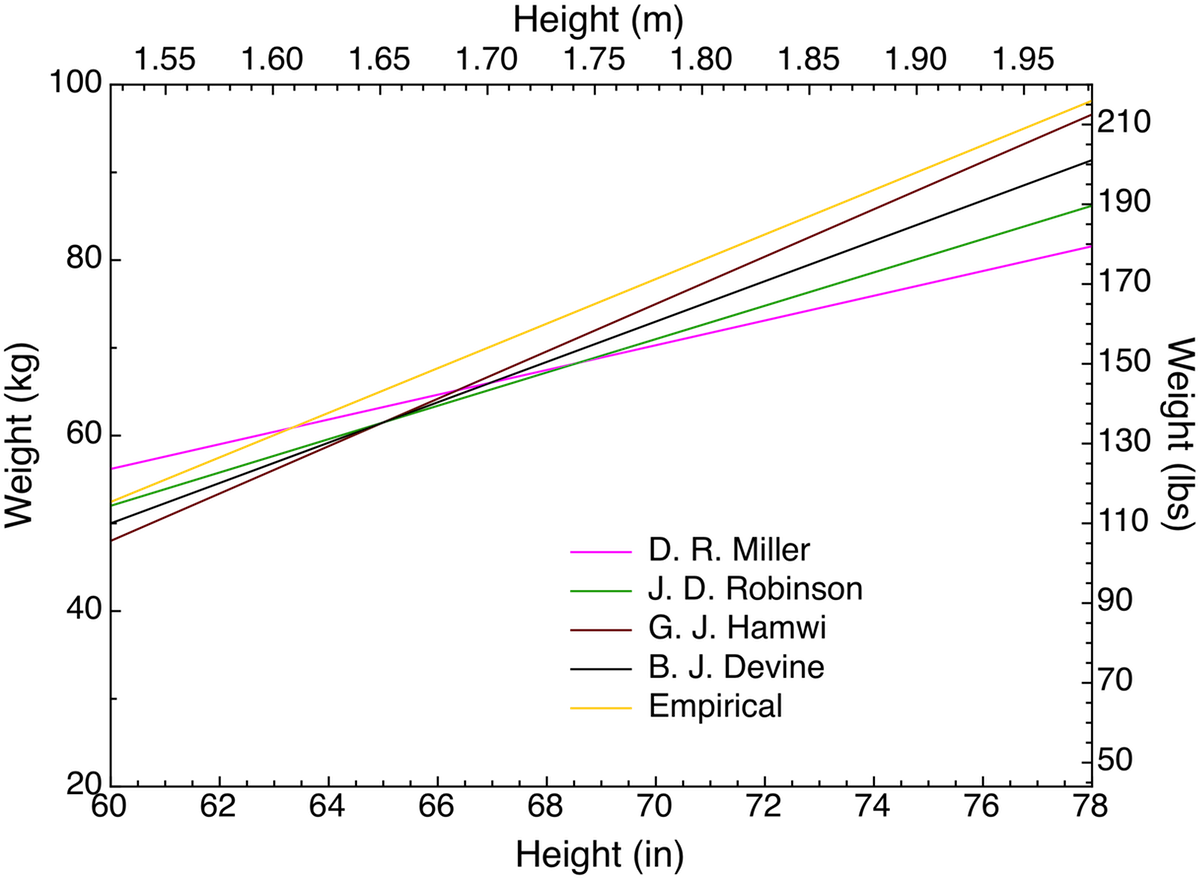
Find your ideal weight:
Note: The calculations are applicable to adults over 5 ft tall (1.52 m)
Although these guidelines gave some answers, they still were not very accurate description and definitely does not fit all the cases. There are people who due to their work they have a greater muscle mass and although they are fit, they might be out of the ideal weight. They are people with different body structure and different bone density. To correct this, another metric, currently used by World Health Organization and major government agencies, was selected; the Body Mass Index or BMI. It was first introduced in 1830 and 1850 by the Belgian polymath Adolphe Quetelet during the course of developing “social physics”. The value is the product of the division of the mass with the square of the height. If you are keen with math:

Calculate your BMI:
Note: Although the calculations are applicable for everyone, the ranking based on the BMI is only for adults.
For the values it is preferred the SI system which dictates the mass to be in kg and the height in m. There is a range if BMI’s that is recommended for healthy adults and there are ranges that signify overweight, underweight and obese individuals. The BMI is considered now a more precise measure as it takes into account the range that humans exhibit in their body type and bone density. The following diagram shows the BMI regions denoting, underweight, normal, overweight and obese. The ranges are suitable for about 80% of the population excluding people who have unusually high bode density or muscle mass.
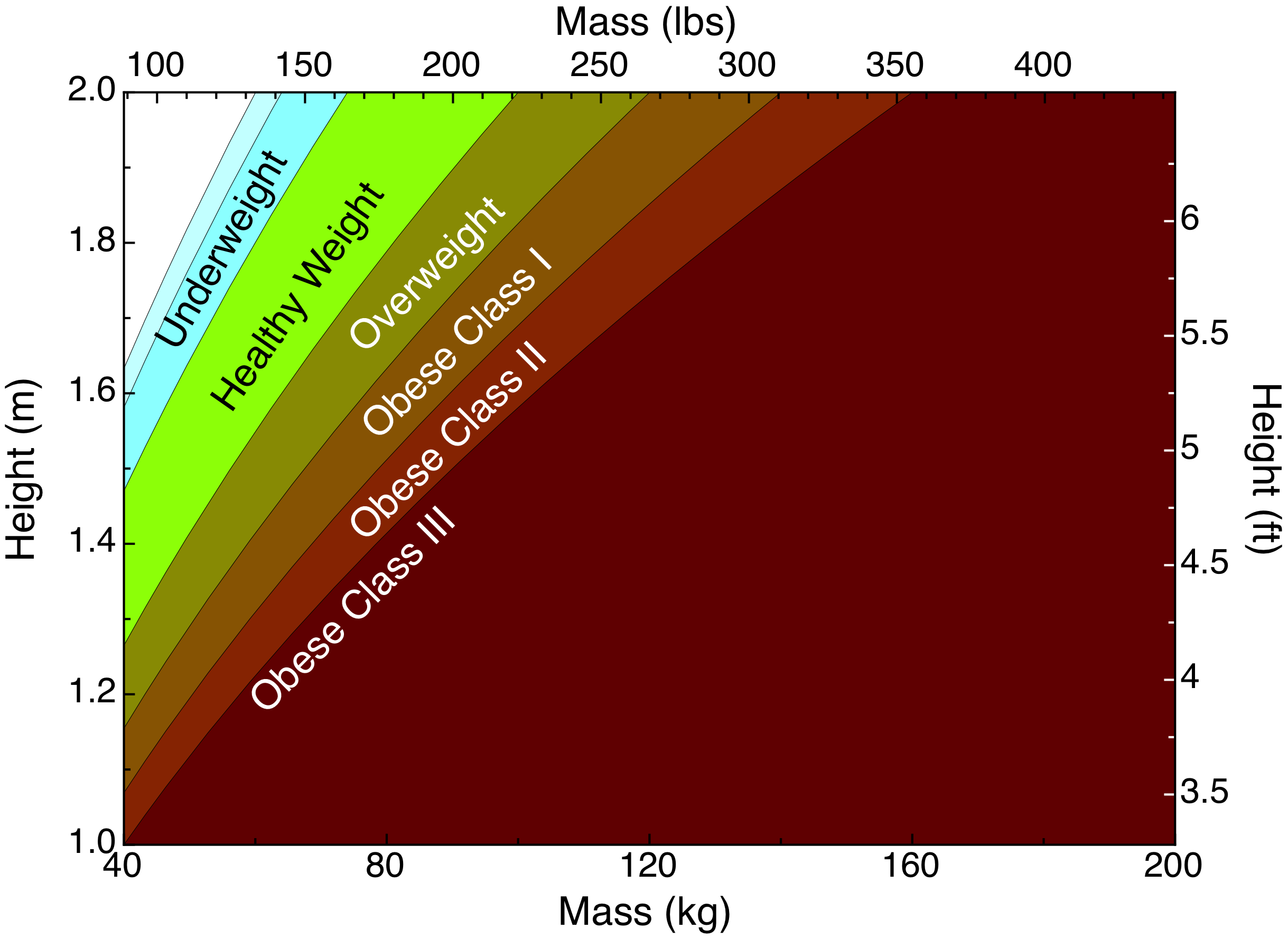
It is interesting to compare the various models with the BMI ranges. This is demonstrated in the following figure. You can see that BMI is wide enough to include all the models, and in addition it is it is promoting a lower weight. The lower limit is set a lot lower from the models lines, compared to the upper limit which is only slightly over the model lines. But the biggest benefit is that it accounts for different body types. bone densities and muscle mass. You can also see my empirical formula that is way off the charts!
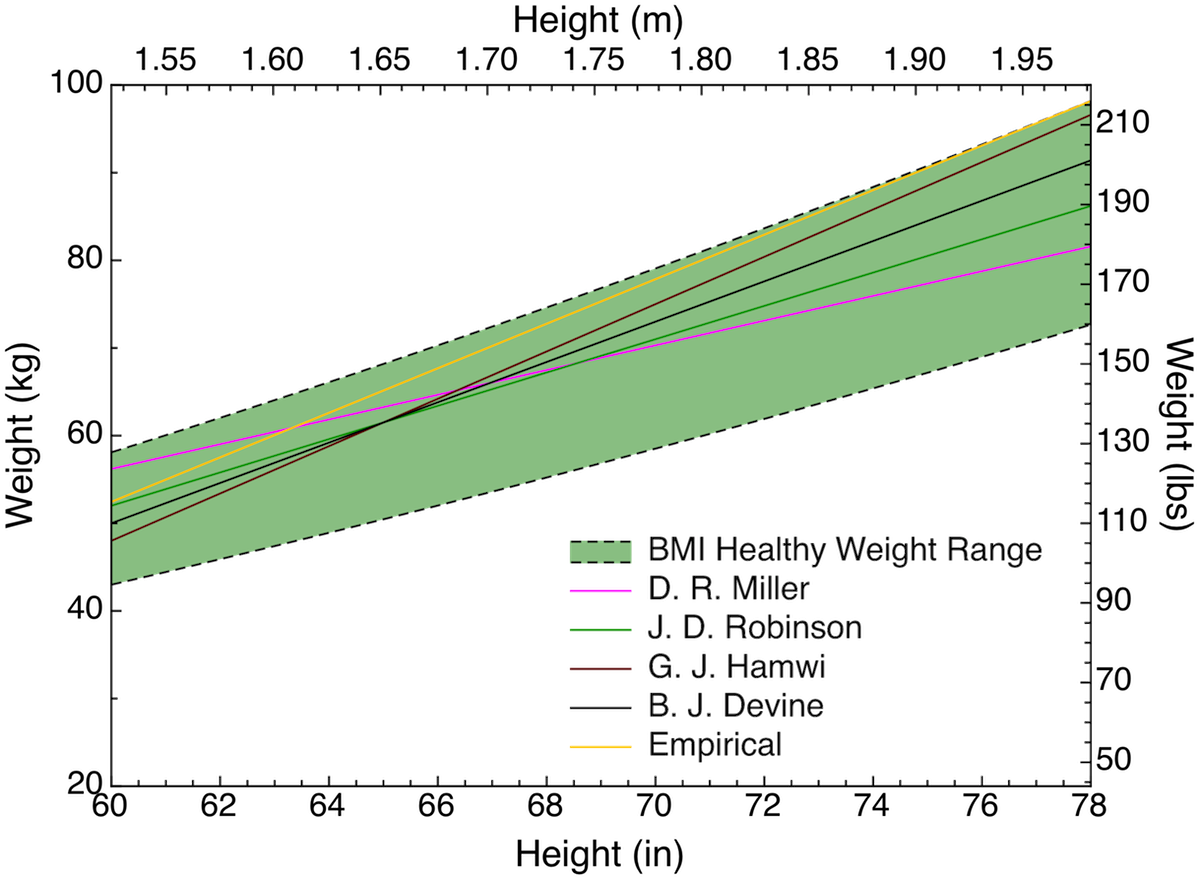
The evolution of the modern diet
Although the calorie concept is still very popular, from the insightful information on how the body functions and utilizes the energy and the food units, it became evident that the except the calorie restrictions there are other ways to reduce the accumulated body fat. One of those breakthroughs came in 1958 from the brain of Dr. Robert Atkins. His idea was simple. If you complete eliminate the carbs from your diet then the body has to consume the fat. Without complicating things more I should mention that during that phase the body is forced to produce ketones (from the fat) that can be converted to acetyl CoA and eventually is used as source of energy and therefore the process is called ketosis. A key component here is that although Atkins diet does not constrict fat intake it relies on the fact that the body fat is easier to break down than other forms of fat.
There is however a catch to that. Your body has an amazing ability to adapt to the environment and the supply or lack of nutrients. So when the body is in state of ketosis, the inclusion of even small amounts of carbs can throw off completely the process and result in weight gain. During this diet although there are not significant restrictions in calories the carbs reduction is a key component. Therefore once someone starts the diet he gets locked in it. Overall the diet has generated controversy. From one side it is a diet that is based on complete altering the human metabolism and the way the body process food with whatever outcomes that can have. On the other hand, it has very quick results to obese people and especially for people who have high blood sugar. Nevertheless this diet had become in the early 2000’s very popular due to the very fast acting and quick results. It was so popular that during that time there was a noticeable reduction in the sales of carb containing products.
The current diet state
Nowadays the diet world is packed with all sort of different types of diets. I personally classify them in three categories; those that restrict calories, those that rely to a balanced diet that is also calorie restricted and those that rely restriction of carbs. The bottom line is however, is that there is no miracle diet. In a recent study U.S. News ranked more than 30 diets based on how easy is to follow, the restrictions, the nutritional value, the level of commitment and the long-term results. The complete article is here and it is definitely a good read.
It is not a surprise that the top diets are those that combine a balance diet with low sodium and rely on low-calorie food items. The top five list has the DASH diet, the TLC diet, the Mayo Clinic diet, the Mediterranean diet and the Weight Watchers diet. Common denominator in all of those is the low consumption of red meat, low fats, low sodium, high consumption of fresh vegetables and fruits, preference to complex carbohydrates and alternative source of protein like fish. Not surprising the bottom of the scale has all those diets that are highly restrictive; Fast diet, the Atkins diet, the Raw Food diet, the Dukan diet and the Paleo diet. The Paleo, the Raw Food and the Atkins are in way similar as all basically prohibit the carbs consumption, while the Dukan diet has a very strict list of allowed food. Finally the Fast are significantly constricts the calorie intake.
However it should be mentioned here, that some of these diets are important not for losing way, but because the restrict the intake of foods that can have adverse effects on some people. So for instance the Paleo diet is an amazing lifestyle for those that have the Celiac disease and cannot eat gluten. Similar the Atkins is still a good option for diabetics.
Epilogue
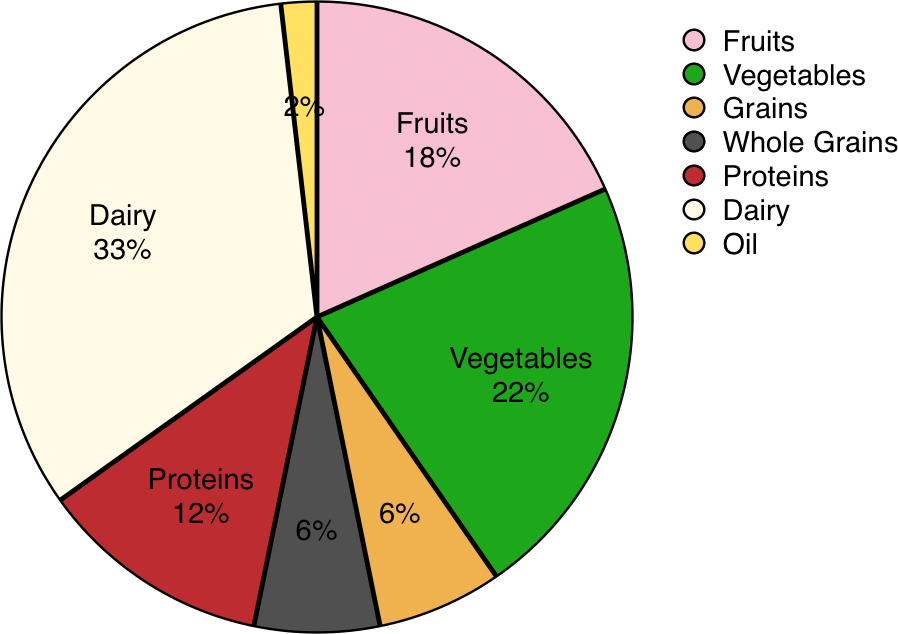 Overall the key component of a successful diet is to see it as the original meaning of the word diet as ti was defined by Greeks: an overall lifestyle change that will result in a healthier you. A way that will train yourself to eat better and healthier. Follow a balanced diet, where not only the amount of proteins, carb and fats, but also where is coming from. In the abundance of foods it is hard to keep up with proper eating habits. A good place to start is the balanced diet according to the USDA guidelines that are described under the general terms of MyPlate, which in 2011 replaced the famous nutrition pyramid. The distinction was necessary to accommodate need to distinguish between all the different food items. According to USDA and WHO a daily balanced diet must include:
Overall the key component of a successful diet is to see it as the original meaning of the word diet as ti was defined by Greeks: an overall lifestyle change that will result in a healthier you. A way that will train yourself to eat better and healthier. Follow a balanced diet, where not only the amount of proteins, carb and fats, but also where is coming from. In the abundance of foods it is hard to keep up with proper eating habits. A good place to start is the balanced diet according to the USDA guidelines that are described under the general terms of MyPlate, which in 2011 replaced the famous nutrition pyramid. The distinction was necessary to accommodate need to distinguish between all the different food items. According to USDA and WHO a daily balanced diet must include:
- 2 cups of fruits
- 3 cups of vegetables
- 7-8 ounce grains from which 3½-4 must be whole grains
- 6 ½ ounce proteins
- 3 cups dairy
- 6-7 teaspoons of oils
This might not guarantee a leaner you, but will result in a better you. The next following posts will deal more with the topic. The next post will be a comparison between the two leading diets the weight watchers and calorie restriction following the Mayo clinic diet. Then I will have a small discussion we some experts on the field on some of the recent diet trends, the Juicing, the Raw Food and the Paleo diet. And off course I will post some recipes on the way.



